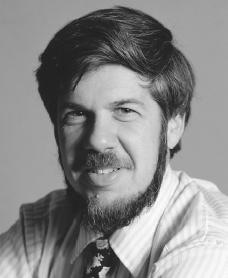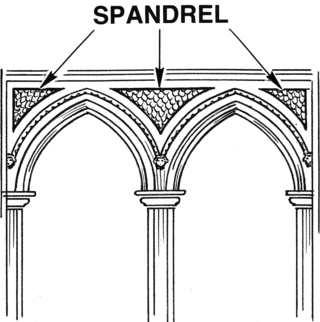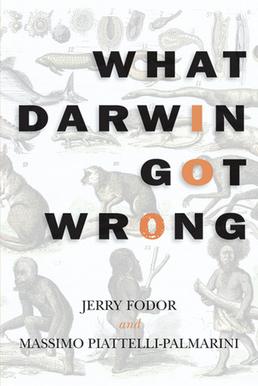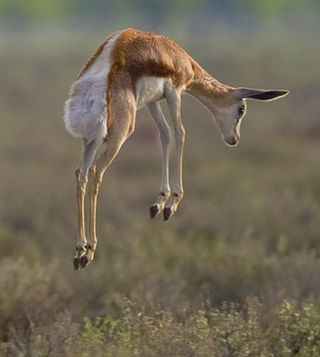
Natural selection is the differential survival and reproduction of individuals due to differences in phenotype. It is a key mechanism of evolution, the change in the heritable traits characteristic of a population over generations. Charles Darwin popularised the term "natural selection", contrasting it with artificial selection, which is intentional, whereas natural selection is not.

Stephen Jay Gould was an American paleontologist, evolutionary biologist, and historian of science. He was one of the most influential and widely read authors of popular science of his generation. Gould spent most of his career teaching at Harvard University and working at the American Museum of Natural History in New York. In 1996, Gould was hired as the Vincent Astor Visiting Research Professor of Biology at New York University, after which he divided his time teaching between there and Harvard.

The neutral theory of molecular evolution holds that most evolutionary changes occur at the molecular level, and most of the variation within and between species are due to random genetic drift of mutant alleles that are selectively neutral. The theory applies only for evolution at the molecular level, and is compatible with phenotypic evolution being shaped by natural selection as postulated by Charles Darwin.

Richard Charles Lewontin was an American evolutionary biologist, mathematician, geneticist, and social commentator. A leader in developing the mathematical basis of population genetics and evolutionary theory, he applied techniques from molecular biology, such as gel electrophoresis, to questions of genetic variation and evolution.
In biology, adaptation has three related meanings. Firstly, it is the dynamic evolutionary process of natural selection that fits organisms to their environment, enhancing their evolutionary fitness. Secondly, it is a state reached by the population during that process. Thirdly, it is a phenotypic trait or adaptive trait, with a functional role in each individual organism, that is maintained and has evolved through natural selection.
Teleonomy is the quality of apparent purposefulness and of goal-directedness of structures and functions in living organisms brought about by natural processes like natural selection. The term derives from two Greek words, τέλος, from τελε-, and νόμος nomos ("law"). Teleonomy is sometimes contrasted with teleology, where the latter is understood as a purposeful goal-directedness brought about through human or divine intention. Teleonomy is thought to derive from evolutionary history, adaptation for reproductive success, and/or the operation of a program. Teleonomy is related to programmatic or computational aspects of purpose.
In science and philosophy, a just-so story is an untestable narrative explanation for a cultural practice, a biological trait, or behavior of humans or other animals. The pejorative nature of the expression is an implicit criticism that reminds the listener of the fictional and unprovable nature of such an explanation. Such tales are common in folklore genres like mythology. A less pejorative term is a pourquoi story, which has been used to describe usually more mythological or otherwise traditional examples of this genre, aimed at children.

Biological or process structuralism is a school of biological thought that objects to an exclusively Darwinian or adaptationist explanation of natural selection such as is described in the 20th century's modern synthesis. It proposes instead that evolution is guided differently, basically by more or less physical forces which shape the development of an animal's body, and sometimes implies that these forces supersede selection altogether.

In evolutionary biology, a spandrel is a phenotypic trait that is a byproduct of the evolution of some other characteristic, rather than a direct product of adaptive selection. Stephen Jay Gould and Richard Lewontin brought the term into biology in their 1979 paper "The Spandrels of San Marco and the Panglossian Paradigm: A Critique of the Adaptationist Programme". Adaptationism is a point of view that sees most organismal traits as adaptive products of natural selection. Gould and Lewontin sought to temper what they saw as adaptationist bias by promoting a more structuralist view of evolution.
Many scientists and philosophers of science have described evolution as fact and theory, a phrase which was used as the title of an article by paleontologist Stephen Jay Gould in 1981. He describes fact in science as meaning data, not known with absolute certainty but "confirmed to such a degree that it would be perverse to withhold provisional assent". A scientific theory is a well-substantiated explanation of such facts. The facts of evolution come from observational evidence of current processes, from imperfections in organisms recording historical common descent, and from transitions in the fossil record. Theories of evolution provide a provisional explanation for these facts.
In evolutionary biology, function is the reason some object or process occurred in a system that evolved through natural selection. That reason is typically that it achieves some result, such as that chlorophyll helps to capture the energy of sunlight in photosynthesis. Hence, the organism that contains it is more likely to survive and reproduce, in other words the function increases the organism's fitness. A characteristic that assists in evolution is called an adaptation; other characteristics may be non-functional spandrels, though these in turn may later be co-opted by evolution to serve new functions.
Evolutionary psychology seeks to identify and understand human psychological traits that have evolved in much the same way as biological traits, through adaptation to environmental cues. Furthermore, it tends toward viewing the vast majority of psychological traits, certainly the most important ones, as the result of past adaptions, which has generated significant controversy and criticism from competing fields. These criticisms include disputes about the testability of evolutionary hypotheses, cognitive assumptions such as massive modularity, vagueness stemming from assumptions about the environment that leads to evolutionary adaptation, the importance of non-genetic and non-adaptive explanations, as well as political and ethical issues in the field itself.

What Darwin Got Wrong is a 2010 book by philosopher Jerry Fodor and cognitive scientist Massimo Piattelli-Palmarini, in which the authors criticize Charles Darwin's theory of natural selection. It is an extension of an argument first presented as "Why Pigs Don't Have Wings" in the London Review of Books.
Phylogenetic inertia or phylogenetic constraint refers to the limitations on the future evolutionary pathways that have been imposed by previous adaptations.

Teleology in biology is the use of the language of goal-directedness in accounts of evolutionary adaptation, which some biologists and philosophers of science find problematic. The term teleonomy has also been proposed. Before Darwin, organisms were seen as existing because God had designed and created them; their features such as eyes were taken by natural theology to have been made to enable them to carry out their functions, such as seeing. Evolutionary biologists often use similar teleological formulations that invoke purpose, but these imply natural selection rather than actual goals, whether conscious or not. Some biologists and religious thinkers held that evolution itself was somehow goal-directed (orthogenesis), and in vitalist versions, driven by a purposeful life force. With evolution working by natural selection acting on inherited variation, the use of teleology in biology has attracted criticism, and attempts have been made to teach students to avoid teleological language.
Human evolutionary developmental biology or informally human evo-devo is the human-specific subset of evolutionary developmental biology. Evolutionary developmental biology is the study of the evolution of developmental processes across different organisms. It is utilized within multiple disciplines, primarily evolutionary biology and anthropology. Groundwork for the theory that "evolutionary modifications in primate development might have led to … modern humans" was laid by Geoffroy Saint-Hilaire, Ernst Haeckel, Louis Bolk, and Adolph Schultz. Evolutionary developmental biology is primarily concerned with the ways in which evolution affects development, and seeks to unravel the causes of evolutionary innovations.

Alternatives to Darwinian evolution have been proposed by scholars investigating biology to explain signs of evolution and the relatedness of different groups of living things. The alternatives in question do not deny that evolutionary changes over time are the origin of the diversity of life, nor that the organisms alive today share a common ancestor from the distant past ; rather, they propose alternative mechanisms of evolutionary change over time, arguing against mutations acted on by natural selection as the most important driver of evolutionary change.
In evolutionary biology, developmental bias refers to the production against or towards certain ontogenetic trajectories which ultimately influence the direction and outcome of evolutionary change by affecting the rates, magnitudes, directions and limits of trait evolution. Historically, the term was synonymous with developmental constraint, however, the latter has been more recently interpreted as referring solely to the negative role of development in evolution.
"The Spandrels of San Marco and the Panglossian Paradigm: A Critique of the Adaptationist Programme", also known as the "Spandrels paper", is a paper by evolutionary biologists Stephen Jay Gould and Richard Lewontin, originally published in the Proceedings of the Royal Society B: Biological Sciences in 1979. The paper criticizes the adaptationist school of thought that was prevalent in evolutionary biology at the time using two metaphors: that of the spandrels in St Mark's Basilica, a cathedral in Venice, Italy, and that of the fictional character "Pangloss" in Voltaire's novella Candide. The paper was the first to use the architectural term "spandrel" in a biological context; the term "spandrel" has since gained currency in biology to refer to byproducts of adaptation.
Constructive neutral evolution(CNE) is a theory that seeks to explain how complex systems can evolve through neutral transitions and spread through a population by chance fixation (genetic drift). Constructive neutral evolution is a competitor for both adaptationist explanations for the emergence of complex traits and hypotheses positing that a complex trait emerged as a response to a deleterious development in an organism. Constructive neutral evolution often leads to irreversible or "irremediable" complexity and produces systems which, instead of being finely adapted for performing a task, represent an excess complexity that has been described with terms such as "runaway bureaucracy" or even a "Rube Goldberg machine".









